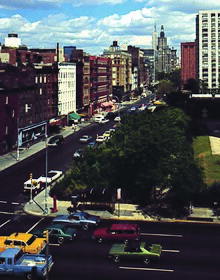Alan Sonfist
| Alan Sonfist | |
|---|---|

Time Landscape of New York
|
|
| Born | Bronx, New York City |
| Education | MIT Center for Advanced Visual Studies |
| Known for | Sustainable Art |
| Movement | Environmental Art |
Alan Sonfist is a New York City based American artist most often associated with the Land or Earth Art movement.
He is best known for his "Time Landscape" found on the corner of West Houston Street and LaGuardia Place in New York City's Greenwich Village. Proposed in 1965, "Time Landscape" the environmental sculpture took over ten years of careful planning with New York City. It was eventually landmarked by the city. It has often been cited as the first urban forest of its kind. More recently, Sonfist has continued to create artworks within the natural landscape, inaugurating a one-acre (4,000 m²) landscape project titled "The Lost Falcon of Westphalia" on Prince Richard's estate outside Cologne, Germany in 2005.
In Nature: The End of Art, environmentalist Jonathan Carpenter writes that "To review the public sculptures of Alan Sonfist since the 1960s is to witness the reemergence of the socially aware artist. His sculptures reassert the historical role of the artist as an active initiator of ideas within society. Each of his artworks fundamentally redefine what sculpture is, who the artist is, and how art should function for its public."
Beginning with his first major commissioned work, “Time Landscapes” in Greenwich Village, NYC, Sonfist received critical acclaim for his innovative use of urban spaces to design havens of nature and green art. His early work in the 1960s and 1970s helped pioneer the burgeoning movement of site-specific sculpture. Today, he continues to promote sustainable energy and strives to raise awareness for global climate change with his international projects. Recently, Sonfist collaborated with Green City Planners in Pori, Finland and Tampa, Florida to create green public spaces.
Sonfist's work derives from an early childhood anxiety towards deforestation. As the Financial Times writes: "One of the pioneers of environmental art, Sonfist’s passion for nature was triggered by his childhood nearby a hemlock forest, which has now died. 'I watched it disappear as people tried to improve upon it,' he tells me sadly. A gentle soul in a pinstriped suit and straw trilby, he believes nature is safest 'when left to be like it is'."
He later attended Hunter College, where he received a Masters in Art. In addition to his studies at Hunter College, he also studied with Gestalt psychologist, Hoyt Sherman at Ohio State University. His research there concerned the language of visual culture and its relationship with human psychology. Later, he went on to pursue a Research Fellowship in visual studies at MIT, Cambridge, MA. After his breakthrough Time Landscape of New York, Sonfist gradually built a reputation as a father of the environmental art movement, presenting a new and unique harmony between ecology and artistry. In 1971, Joshua Taylor, Director of the American Museum of Art, wrote of "Autobiography of Alan Sonfist", a one-person exhibition at the Smithsonian Institution, "[...] some--like Alan Sonfist [...] have reacted to a cosmic consciousness by returning to specific nature in its smallest detail. For art in America, the landscape has meant freedom and expansion, or, when useful, discipline and concentration. But once the artist took possession of his environment, the natural bounty of America was never far from the surface of his art."
...
Wikipedia
